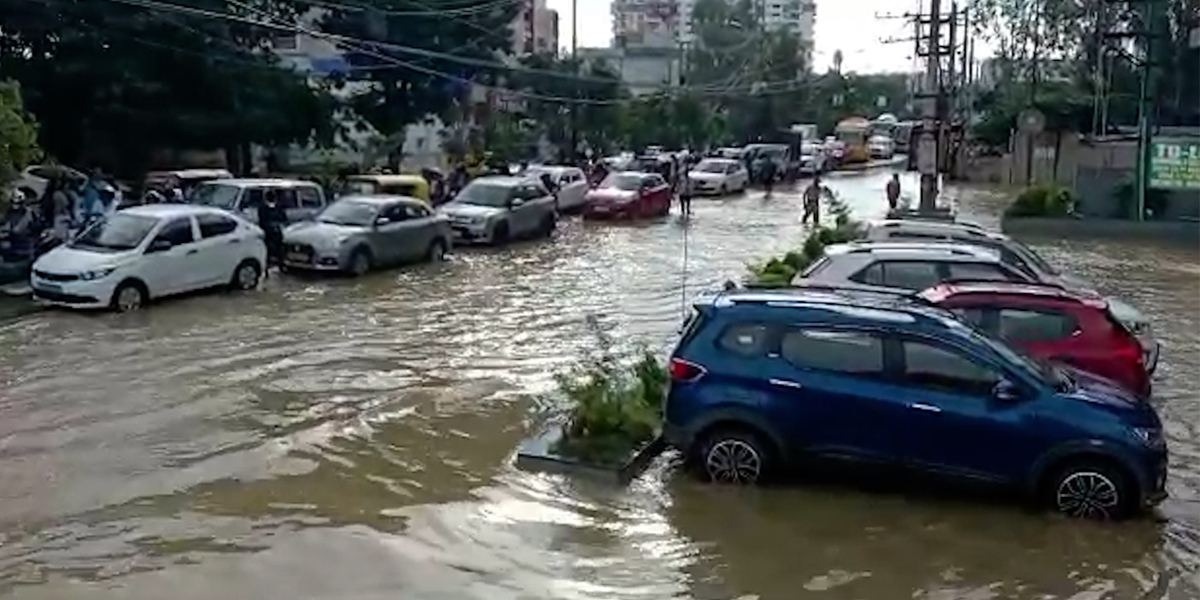Bengaluru currently has nearly 1,000 km of rajakaluves. Traditionally, they were protected by buffer zones ranging between 500 metres and 1,000 metres on either side.
Published Oct 02, 2025 | 7:00 AM ⚊ Updated Oct 02, 2025 | 3:23 PM

Bengaluru floods in 2022 (file photo)
Synopsis: Karnataka’s Urban Development Department has proposed drastically reducing buffer zones around Bengaluru’s rajakaluves, cutting them to as little as five metres for tertiary drains, prompting strong opposition from activists and citizen groups. Critics warn that the plan could exacerbate flooding, worsen water scarcity, destroy ecosystems, and render the city effectively unlivable.
Bengaluru may soon see a drastic reduction in the buffer zones around its rajakaluves (stormwater drains), under a new proposal floated by the Karnataka Urban Development Department (UDD). Experts and citizen groups have strongly opposed the move, warning that it will worsen flooding, intensify the city’s water crisis, and destroy fragile ecosystems.
The Draft Regulation No. UDD 468 MNJ 2025 (E), now under consideration, proposes to cut down the buffer zones for stormwater drains in the Bengaluru Metropolitan Region.
The debate comes close on the heels of the controversy over the KTCDA Amendment Bill 2025, which sought to reduce buffer zones for lakes and smaller water bodies. Governor Thaawarchand Gehlot recently returned the Bill, seeking clarifications from the state government after receiving objections from citizens, including the Bengaluru Town Hall association.
The Bill, passed during the monsoon session of the Karnataka legislature, proposed to remove buffer zones altogether for tanks spread across less than five guntas, and to scale buffer zones based on water body size.
Bengaluru currently has nearly 1,000 km of rajakaluves. Traditionally, they were protected by buffer zones ranging between 500 metres and 1,000 metres on either side.
At present, buffer zones stand at 50 metres for primary drains, 35 metres for secondary drains, and 25 metres for tertiary drains. Under the draft regulation, these would be reduced to 15 metres, 10 metres, and 5 metres respectively. Drains leading to tertiary drains would be maintained only as per revenue records, and no buffer would be required for them.
The draft notification classifies drains into three categories:
The proposal has sparked sharp criticism from activists and citizen movements. Sandeep Anirudhan, Convenor of Bengaluru Town Hall, a citizen’s movement, said in a press statement that they have already submitted a memorandum opposing the amendments.
“In our feedback, we have listed the dangers posed by the proposed draft regulations, to the ecology, water security, biodiversity, food security, environment and populations, among others. It will most certainly increase flooding risks, in an already battered Bengaluru. It poses grave threat to the barely remaining green cover in Bengaluru, could lead to the extinction of the last remaining green cover in Bengaluru, pollution of storm water drains and by extension lake waters, erase biodiversity, deepen climate change impacts, and worsen our groundwater crisis,” he said.
“This is unscientific, unsustainable, and unacceptable. Bengaluru will be left a concrete desert, unlivable for all of us.”
The group has also called on the government to withdraw and cancel the notification, and instead consider increasing rajakaluve buffer zones, arguing that the existing buffer zones are already far below what is required for the health of stormwater drains and lakes.
“As per international scientific research, buffer zones of nearly 100 to 300 metres or more are required for storm water drains, to preserve ecosystem integrity, biodiversity, flood control, and water quality,” Anirudhan said.
Nirmala Gowda, Founder and Editor of Mapping Malnad, also objected to the notification. “Buffers are not empty spaces — they are living ecological systems that perform vital hydrological functions, including flood moderation, groundwater recharge, and sediment control,” she wrote in a post on LinkedIn.
“When combined with the Karnataka Tank Conservation & Development Authority (KTCDA) 2025 amendments, that weakened lake buffers, these changes will have severe consequences for floods, water scarcity, and encroachment in Bengaluru.”
In an open letter she shared, she outlined a systematic, evidence-based assessment of the draft regulation and its impacts in six parts:
(Edited by Dese Gowda)
